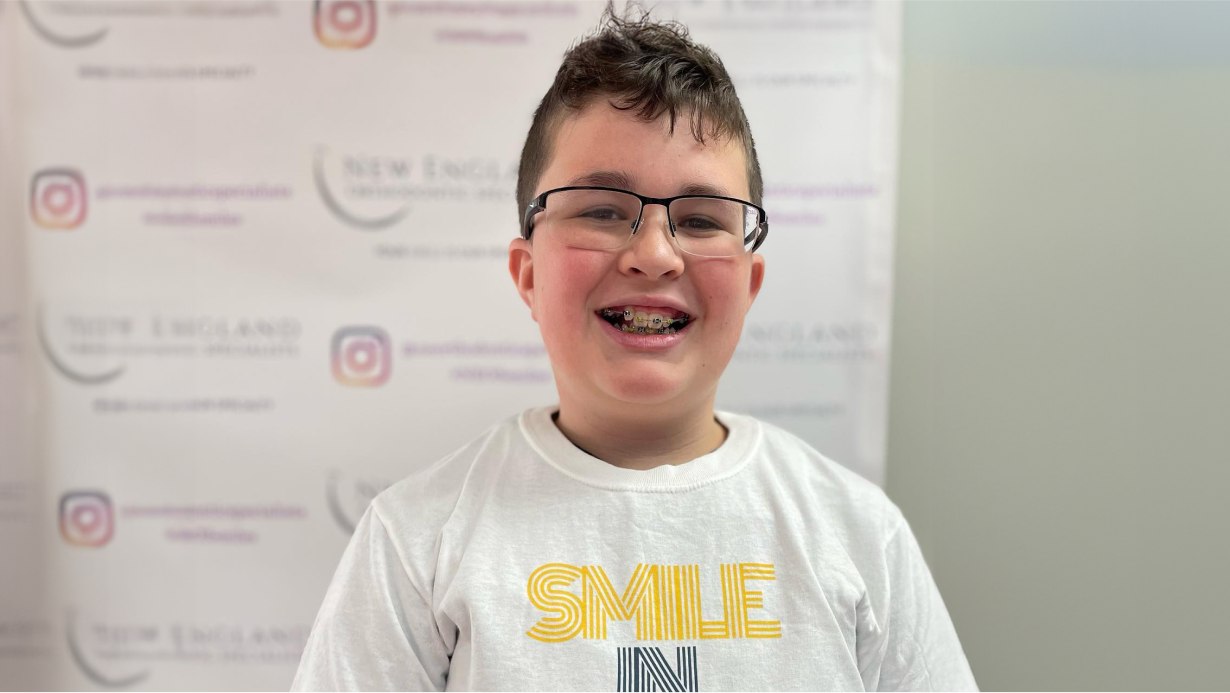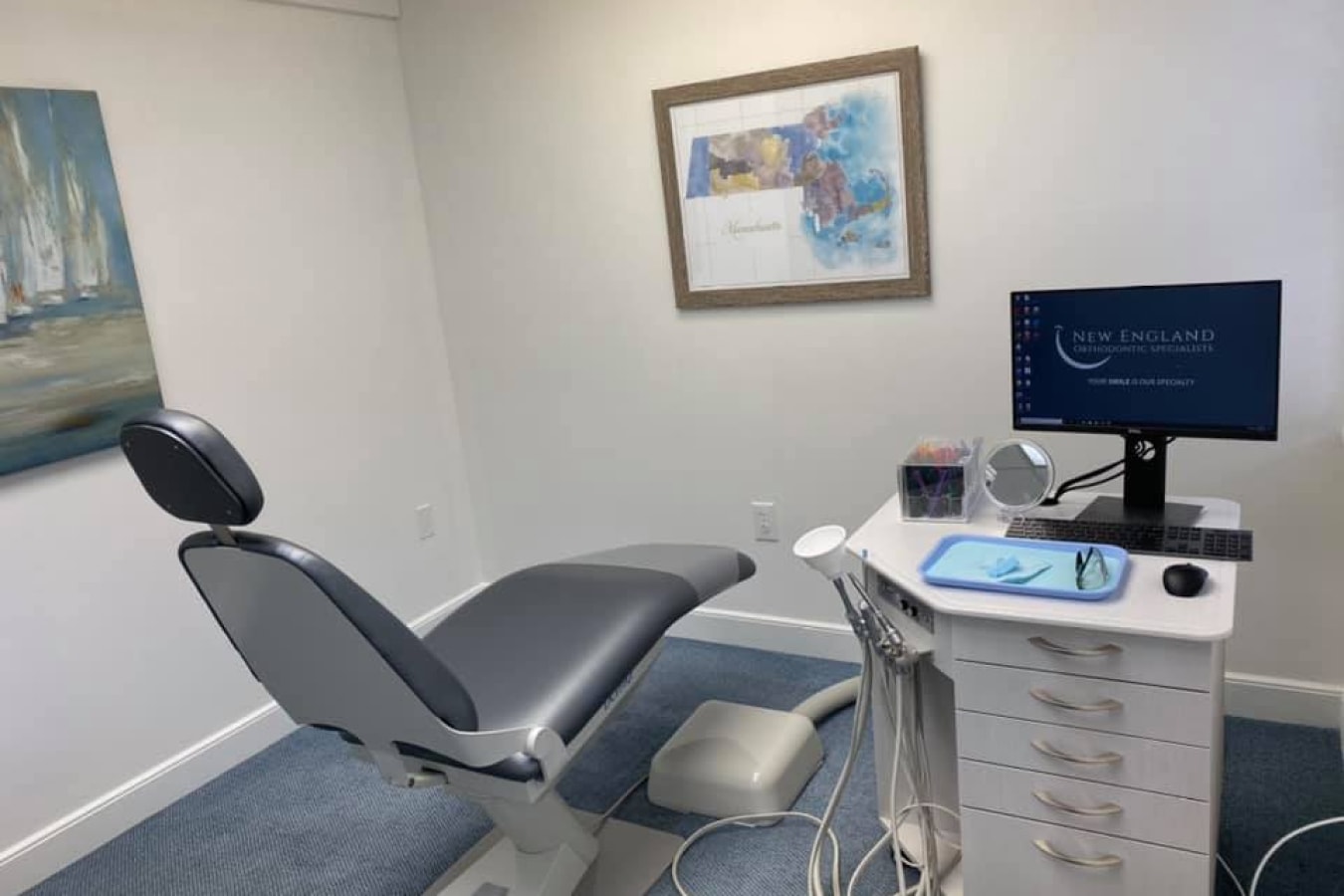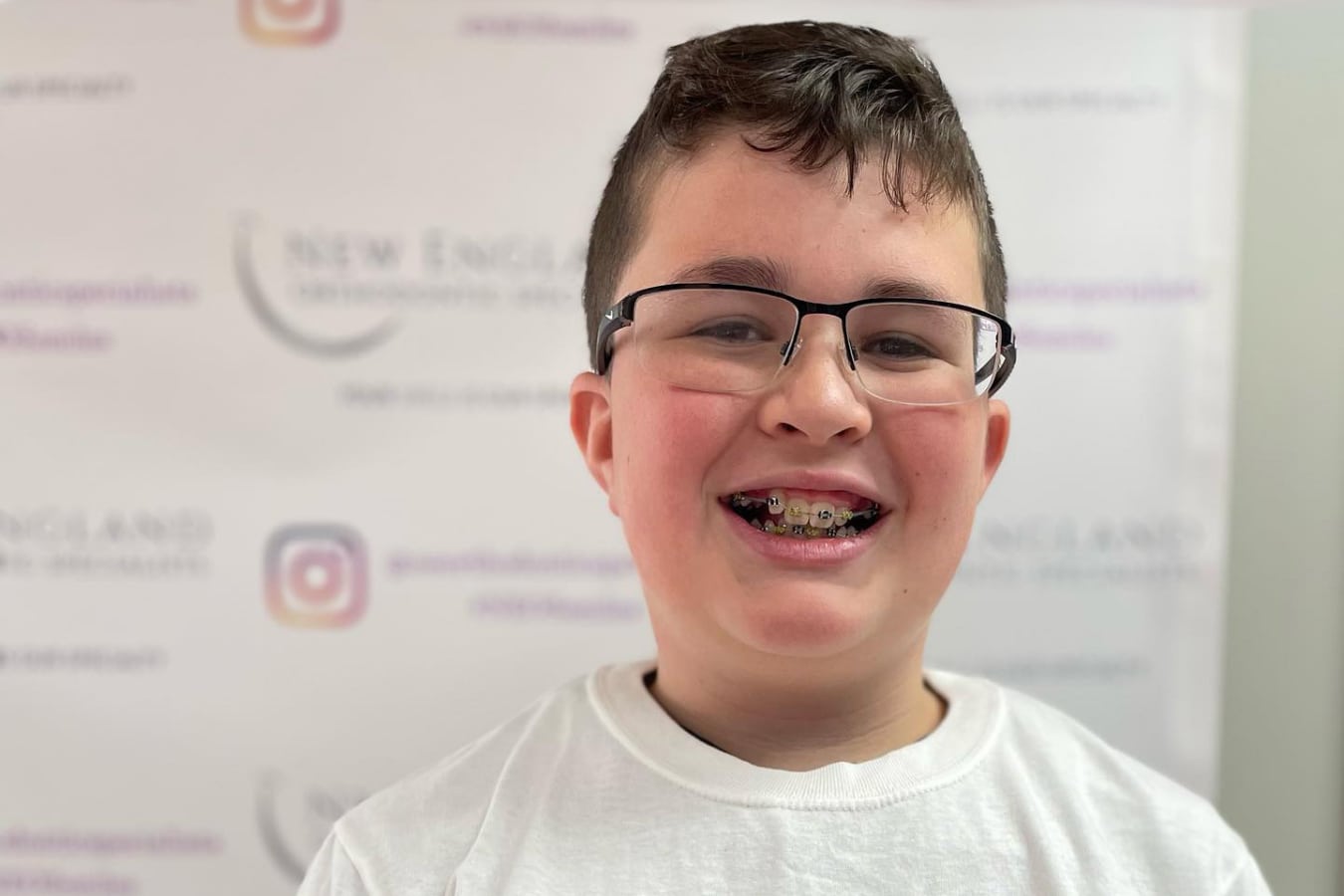Types of Braces

Metal Braces
Traditional braces have been around for a long time, and they're the gold standard of orthodontic treatment. With advancements in the orthodontic field, traditional braces from New England Orthodontic Specialists are not made with the same bulky materials as they had been in the past.
Metal braces have a bad rap for being awkward and obvious. But today, metal braces use smaller and sleeker brackets and lighter wires to improve their appearance. While metal braces might sound uncomfortable, the dental technology we use helps prevent irritation, so they're a more comfortable option than they used to be.
At New England Orthodontic Specialists, we use American Orthodontics Mini Masters Series brackets, which are smaller and smoother than other types of brackets, and feature an angled design that provides more precise and gentle control.
All of this means you'll enjoy a shorter, more comfortable treatment experience. Because metal braces are so effective, you may start to see some small changes in your smile in a short time.
What Are Metal Braces Made of?
Brackets
The brackets Dr. Diana and Dr. Neil use are durable and made from a mix of stainless steel, nickel, and other metals.
Brackets have little hooks or doors where Dr. Diana or Dr. Neil will thread a wire. The bracket can then be secured by closing the door or by placing an elastic over the top of the wire.
Elastics
If Dr. Diana or Dr. Neil determines that you need bite correction, elastics are essential. They're generally strung between an upper bracket hook and a lower bracket hook.
This will pull the upper jaw backward to correct an overbite or the lower jaw back to correct an underbite. We may use rubber bands for many different situations, especially when we want to put extra pressure on the teeth or jaws.
Orthodontic Bands
These are stainless steel rings that are cemented to your teeth using dental bonding agents. These bands can provide an anchor for your braces and orthodontic appliances, but they're not used for everyone.
Dr. Diana or Dr. Neil will determine if your treatment will benefit from orthodontic bands at your initial consultation.
Wire
This thin piece of metal runs from one bracket to another. Dr. Diana and Dr. Neil will change the wire's shape and curvature to move your teeth in the right direction.
The wire will attach all of your bottom or upper teeth together in many cases. We might occasionally cut the wire if connecting just a few teeth is better for your treatment plan.
Spacers
These small elastic "donuts" or rings can be used by Dr. Diana and Dr. Neil to create space between your teeth when needed, typically before bands are placed. They're also referred to as separators.
Glue
This is what Dr. Diana and Dr. Neil will use to attach the brackets to your teeth. It's common to attach the bracket directly to the tooth with glue.
Elastic Ties, O-Rings, Ligatures, Colors
These tiny rubber rings or bands are used to attach the archwire to the brackets. They're less rigid than spacers, and at New England Orthodontic Specialists, they come in dozens of colors.
Clear Braces
At New England Orthodontic Specialists, we offer many safe and effective alternatives to traditional metal braces. For patients who are concerned with aesthetics, we may recommend ceramic braces. Our clear braces are designed to be less noticeable on your teeth than metal braces, and they're smaller than ever and made of nearly invisible tooth-colored polycrystalline ceramic material.
Clear braces are also referred to as ceramic braces, tooth-colored braces, or aesthetic braces, and they work the same way metal braces do. Ceramic braces are exceptionally popular among adult patients and teenagers.
These ceramic options blend in well with your natural smile. Though they're not completely invisible, and the brackets are about the same size and shape, they're much less noticeable than metal braces.
We use 3M Clarity Advanced ceramic braces, which feature a comfortable low-profile design. The transparent and stain-resistant material lets your natural smile shine through.
Ceramic braces offer patients a discreet treatment option, but they can sometimes be slightly more fragile and more expensive than metal braces. Because of this, Dr. Diana and Dr. Neil typically recommend them for older teen and adult patients.
Blend In With Clear Braces
Ceramic brackets are a less obvious way to straighten your smile when paired with clear, white, or tooth-colored wires and elastic ties. This option is especially attractive if you're an aesthetic-minded adult or teen. Ceramic braces are perfect if you want an aesthetic treatment option but don't want the extra hassle of removable aligners and the responsibility of wear time.
Even though most of our New England Orthodontic Specialists patients in ceramic braces love how discrete they are, we do have some teens and adults who like to use colored ligature ties. This gives braces an almost neon look. The colors pop off the clear brackets, creating a really unique look most people haven't seen before.
The Difference Between Traditional & Ceramic Braces
In short, the only major difference between traditional and ceramic braces is the material. Traditional braces are made with metal brackets and use a metal wire. As the name suggests, ceramic braces are made with ceramic materials such as porcelain or zirconia.
Traditional and ceramic braces both operate in the same way, by tightening the wire throughout treatment. Both types of braces also use elastic bands, which attach the wire to the brackets. Since the process is the same, the treatment times are similar.
However, ceramic brackets are much more discrete than metal ones because they're clear and blend in with your teeth. Ceramic braces can also be equipped with transparent wires to make the appliance even less noticeable. On top of that, the elastic bands can also be clear or tooth-colored.
You may be worried about clear braces staining, but this isn't an issue with the high-quality 3M Clarity ceramic brackets we use. The actual ceramic brackets will never stain, unlike the elastic bands. You can choose to avoid things like coffee and tea, red wine, tomatoes, mustard, etc. to cut back on the chance of any staining. This isn't necessary since we change your elastics at every adjustment appointment. As long as you maintain a good oral hygiene routine and follow the treatment plan put in place by Dr. Diana or Dr. Neil, you shouldn't have to worry too much about giving up your morning cup of coffee or evening glass of wine.
Benefits of Ceramic Braces
Ceramic braces have many benefits over traditional braces, some of which include:
- Better Aesthetics — Your brackets, wires, and elastic bands will be much less noticeable than their metal counterparts.
- Smaller Brackets — Ceramic braces also include smaller brackets, which can improve the appearance of your appliance. Smaller brackets can also be more comfortable, causing less friction on the inside of your cheeks and lips. They also make it easier to keep your teeth clean.
- Comparable Results — Ceramic braces can be just as effective as traditional ones, depending on the type of issue that needs correcting. Other aesthetic appliances, such as clear aligner trays, may be more discrete, but they can also be less effective. Ceramic braces are a good middle ground for patients who want optimal results and a discreet appliance.
- Easy Removal — Ceramic braces are easy to remove once your treatment is complete. The type of bonding agent we use also minimizes the possibility of damaging your enamel both during treatment and the removal process.
Cost of Ceramic Braces
One of the biggest factors that affect your treatment cost will be the materials used to make your braces.
In our offices, ceramic brackets cost a little more than metal brackets. The good news is that we offer flexible payment plans and automatic bank drafts, and we will also check with your insurance company for orthodontic benefits. Our goal is to provide outstanding value for reasonable fees!
Treatment fees will vary depending on the complexity of your orthodontic treatment. Dr. Diana and Dr. Neil will determine a treatment fee that fits your specific orthodontic needs, and our office will do everything we can to accommodate you and your budget.
The work it takes to put your braces on, adjust them, and take them off must also be factored into the total treatment cost. Placing and removing ceramic braces are more sensitive to technique and require more time. Our treatment coordinators will be happy to go over the cost with you at your first complimentary consultation.
Best for Adults
After a thorough orthodontic evaluation with Dr. Diana or Dr. Neil, we can determine which treatment option will be best for you and your smile.
At New England Orthodontic Specialists, we think ceramic braces are generally better suited to adults and older teens. This is because ceramic brackets are more likely to break, and they're more expensive than metal brackets
Request a complimentary consultation with Dr. Diana and Dr. Neil at one of our convenient offices to learn if clear braces may be right for you.


Braces for Kids
Get a Head Start on a Beautiful Smile
As a parent, you want the best for your child. That includes healthy teeth and a pleasing smile. Dr. Diana and Dr. Neil will treat your children like their own by giving them the best possible orthodontic care.
Kids Should Get an
Orthodontic Check-Up By 7
By seven years old, your child's teeth have developed enough for subtle problems with jaw growth and emerging teeth to still be spotted while some baby teeth are still present. This check-up may reveal that your child's bite is fine, and braces for kids aren't necessary.
Or, Dr. Diana or Dr. Neil may identify a developing problem but recommend monitoring your child's growth and development, and then, if indicated, begin treatment at the appropriate time for your child. In other cases, Dr. Diana or Dr. Neil might find a problem that can benefit from early treatment.
Choosing the Best Time for Treatment
Sometimes preventive or interceptive orthodontic treatment will be all your child needs. However, there is a good chance your child will require a second phase of comprehensive orthodontic treatment after the child has most or all of their permanent teeth.
While the age at which kids get braces may vary, orthodontic treatment most often begins between 9 and 14. Some orthodontic problems are easier to correct if they're treated early.
If Dr. Diana or Dr. Neil thinks your child will need treatment, he'll let you know when it will be best to begin treatment. This gives your orthodontist the best chance to:
- Guide jaw growth
- Lower the risk of trauma to protruded front teeth
- Correct harmful oral habits
- Improve appearance and self-esteem in your child
- Guide permanent teeth into a more favorable position
- Create a more pleasing arrangement of teeth, lips, and face
In short, Dr. Diana and Dr. Neil will be able to determine the best time to start treatment to give your child their most beautiful smile, so they can be their most confident self.
What Is Early Treatment?
The goal of interceptive treatment could be to create enough space for permanent teeth to erupt into the mouth or to help guide the growth of your child's jaws.
Early treatment may prevent or intercept more serious problems from developing and may make treatment at a later age shorter and less complicated.
In some cases, Dr. Diana and Dr. Neil can achieve results that may not be possible once the face and jaws have finished growing.
Not all orthodontic treatment uses braces. Interceptive treatment could simply be removing a stubborn baby tooth so the permanent tooth can erupt correctly.
Some children may need help positioning their tongue when they swallow, while others may need intervention to stop a thumb- or finger-sucking habit. These issues are sometimes treated with habit appliances.
If your child's upper jaw is too narrow so that the permanent teeth do not have room to come in, interceptive treatment could consist of a palate expander to widen the upper jaw.
Tell-Tale Signs the Bite's Not Right
It's not always easy to tell when your child may need braces or has an orthodontic problem. Even teeth that look straight may be hiding a problem bite.
Here are some clues that may indicate the need for orthodontic attention:
- Early or late loss of baby teeth
- Difficulty chewing or biting
- Breathing through the mouth
- Thumb-sucking
- Crowded, misplaced, or blocked-out teeth
- Jaws that are too far forward or back
- Biting the cheek or biting into the roof of the mouth
- Protruding teeth
- Upper and lower teeth that don't meet, or meet in an abnormal way
- An unbalanced facial appearance
- Grinding or clenching of the teeth
If your child has a dental issue, please contact us by requesting a free consultation at one of our offices. We can talk about your child's orthodontic options and develop a treatment plan customized to your child's needs.

Braces for Teens
The teen years (between the ages of 12 and 16) are the most common time for orthodontic treatment because most permanent teeth will be in place.
Luckily, some new solutions at New England Orthodontic Specialists work to make the treatment process much easier than ever before.
All About Teen Orthodontics
Experienced orthodontists like Dr. Diana and Dr. Neil can easily recognize issues with spacing, crowding, bite, and alignment in this age range, and your teen's bone and jaw structure are formed enough to allow orthodontic treatment to begin.
Some teens may have even started Phase I treatment at an earlier age and are now following it up with full braces or other orthodontic treatment.
Beyond outward appearances, untreated dental problems can have a lasting impact on your teen's oral and overall health. If you notice any of the following issues, we recommend a free consultation with Dr. Diana and Dr. Neil at New England Orthodontic Specialists since they could be signs your teen may benefit from orthodontic treatment.
- Early, late, or irregular loss of their baby teeth
- Difficulty with chewing or biting
- Crowding or extra spacing between teeth
- Jaws that shift or make sounds
- Frequent biting of the cheek or the inside of the mouth
- Teeth that meet abnormally or not at all
- Jaws and teeth that are out of proportion to the rest of the face
- Protrusion of teeth
Bad Bites
Diagnosing and successfully treating certain bite problems can have short-term and long-term benefits. Problems classified as "bad bites" can often be minimized with the proper orthodontic treatment, including:
- Crooked or crowded teeth
- Missing or extra teeth
- An overbite or underbite
- Incorrect jaw position
- A disorder of the jaw joint
Benefits of a Straight Smile
Straight teeth that respond well to orthodontic treatment have many benefits, including:
- Being less prone to wear and tear, chipping, and tooth trauma
- Being easier to keep clean, helping to prevent tooth decay and cavities
- Reducing the chances of developing gum disease, which can result in bone loss, decay, and tooth loss
- Improving proper chewing and digestion of food
Orthodontic treatment is an investment in your child's future. During your free consultation, Dr. Diana and Dr. Neil will be happy to discuss the benefits of treatment as well as the risks of putting it off.
Although adults can successfully complete orthodontic treatment, a teen's jaws, and teeth can respond quicker to orthodontic treatment, shortening their total treatment time.
Braces for Adults
It's Never Too Late for a Confident Smile
Your smile is the first thing other people notice about you. Do you love yours? You're never too old to benefit from orthodontic treatment.
Get the Smile You Deserve
Braces aren't just for kids. Many adults are taking the plunge and enjoying the benefits of orthodontic care no matter their age.
Straight teeth, a healthy bite, and proper tooth alignment make your overall oral health better. There are lots of reasons why adults haven't had the opportunity to get braces in the past.
With improved aesthetic choices, better technologies, and affordable financing options, it's the perfect time to treat yourself to a new smile.
Maybe orthodontic treatment is something you have been thinking about for yourself for a long time but instead have focused on braces for your children. Well, now is the time to start thinking about YOU!
Reasons for Adult Orthodontics
Today, adults make up about one in every five orthodontic patients. Here's why:
Teeth Can Shift
Believe it or not, your teeth don't stop moving in adolescence. Teeth that seemed straight and aligned in youth could have shifted later in life. This can lead to jaw pain, trouble brushing, or a smile you're unhappy with.
Looking Good
Orthodontic treatment can help correct crooked teeth or spaces that you've been self-conscious about for years. It can give you the confidence and pride that come with straight teeth and a great smile.
Maintaining Dental Health
If you leave misaligned teeth untreated, you may end up with other dental problems such as tooth decay and gum disease. You may also notice difficulty chewing or abnormal wear on the surface of your teeth.

Free Consultations for Adults
Adult consultations are a bit different than our consultations for children and teens. Before deciding on any type of orthodontic treatment, Dr. Diana Esshaki and Dr. Neil Flückiger have to check for any existing issues with your oral health.
Gum diseases can weaken the periodontal tissues, making it much more challenging to move your teeth, so we may recommend a periodontal evaluation to check for any evidence of gum disease.
If you're in good oral health, we can move forward with orthodontic treatment at New England Orthodontic Specialists. Your consultation is also a great opportunity to ask questions and voice and concerns.
Some of the most common questions include:
- Is orthodontics appropriate for my situation?
- How long will my treatment take?
- How much does treatment cost?
- What type of treatment do I need to correct the problem?
- Will my insurance cover orthodontic treatment?
Start your journey towards a healthy new smile today and request your free consultation with Dr. Diana or Dr. Neil. Let's talk about your orthodontic options and develop a treatment plan customized to your needs and smile goals.